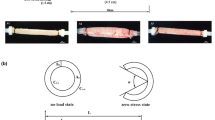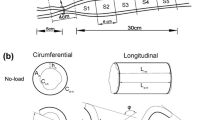Abstract
The morphometry at no-load and zero-stress states and residual circumferential strains were determined along the pig duodenum in vitro in seven pigs. The no-load state was obtained by cutting eleven 2-mm-wide rings at 10% intervals along the duodenum. The zero-stress state was obtained by cutting the rings radially. The zero-stress state provides a standard morphological state to describe tissue since internal and external forces do not affect the tissue. The morphometric measures were obtained from digitized images, and the layer thicknesses were measured from histological sections. The mucosal and serosal circumferences, the wall thickness, and the wall thickness-to-mucosal radius ratio were largest in the proximal end of the duodenum (f > 1.9, P < 0.05). The thickness of the submucosal stratum compactum layer and the opening angle increased in distal direction (f = 2.3, P < 0.05 and f = 6.5, P < 0.001). The residual strain at the mucosal surface was negative, indicating that the mucosa–submucosa layers of duodenum in no-load state are in compression. Distension experiments showed that the residual strain makes the stress distribution through the wall more uniform in the pressurized state. In conclusion, the large circumferential residual strains must be taken into account in the study of physiological problems, in which the stresses and strains are important, eg, the bolus transport function.
Similar content being viewed by others
REFERENCES
Ehrlein HJ, Scheemann M, Siegle MI: Motor patterns of small intestine determined by closely spaced extraluminal transducers and videofluoroscopy. Am J Physiol 253:G259–G267, 1987
Kellow JE, Borody TJ, Phillips SF, Tucker R, Haddad AC: Human interdigestive motility: Variations in patterns from esophagus to colon. Gastroenterology 91:386–395, 1996
Schulze-Delrieu K, Brown BP, Custer-Hagen T: Contraction and accommodation of guinea pig duodenum in vitro. Am J Physiol 261:G364–G372, 1991
Yamada H: Strength of Biological Materials. Baltimore, Maryland, Williams & Wilkins, 1970
Weems WA: Intestinal fluid flow: Its production and control. In Physiology of the Gastrointestinal Tract. LR Johnson (ed). New York, Raven Press, 1987, pp 571–593
Storkholm JH, Villadsen GE, Jensen SL, Gregersen H: Passive elastic wall properties in the isolated guinea pig small intestine. Dig Dis Sci 40:976–982, 1995
Han HC, Fung YC: Species difference of the zero-stress state of aorta: pig vs rat. J Biomech Eng 113:446–451, 1991
Fung YC: What principle governs the stress distribution in living organs? In Biomechanics in China, Japan and USA. YC Fung, E Fukada, J Wang (eds). Beijing, Science, 1984, pp 1–13
Fung YC: Biomechanics: Mechanical Properties of Living Tissues. New York, Springer-Verlag 1993
Han HC, Fung YC: Residual strain in porcine and canine trachea. J Biomech 24:307–315, 1991
Liu SQ, Fung YC: Zero-stress state of arteries. J Biomech Eng 110:82–84, 1988
Vaishnav RN, Vossoughi J: Estimation of residual strains in aortic segments. In Biomedical Engineering II. Recent Developments. CW Hall (ed). New York, Pergamon, 1983, pp 330–333
Gregersen H, Kassab G: Morphometry and strain distribution in guinea pig duodenum with reference to the zero-stress state. Am J Physiol 273:G865–G874, 1997
Gabella G: Structure of muscles and nerves in the gastrointestinal tract. In Physiology of the Gastrointestinal Tract. LR Johnson (ed). New York, Raven Press, 1987, pp 335–382
Meyer JH, Gu Y, Elashoff J, Reedy T, Dressman J, Amidon G: Effects of viscosity and fluid outflow on postcibal gastric emptying of solids. Am J Physiol 250:G161–G164, 1986
Siegle ML, Ehrlein HJ: Effects of various agents on ileal postprandial motor patterns and transit of chyme in dogs. Am J Physiol 257:G698–G703, 1989
Fung YC: Biomechanics: Motion, Flow, Stress and Growth. New York, Springer-Verlag, 1990
Fung YC, Liu SQ: Changes of the zero-stress state of rat pulmonary arteries in hypoxic hypertension. J Appl Physiol 70:2455–2470, 1991
Liu SQ, Fung YC: Relationship between hypertension hypertrophy, and opening angle of zero-stress state of arteries following aortic constriction. J Biomech Eng 111:325–335, 1989
Omens JH, Fung YC: Residual strain in the rat left ventricle. Circ Res 66:37–45, 1990
Vossoughi JH, Weizsacker E, Vaishnav RN: Variation of aortic geometry in various animal species. Biomed Tech 30:48–54, 1985
Xie JP, Liu SQ, Yang RF, Fung YC: The zero-stress state of rat veins and vena cava. J Biomech Eng 113:36–41, 1991
Chuong CJ, Fung YC: On residual stresses in arteries. J Biomech Eng 108:189–199, 1986
Gabella G: The cross ply arrangement of collagen fibres in submucosa of the mammalian small intestine. Cell Tissue Res 248:491–497, 1987
Graham MF, Diegelmann RF, Elson CO, Lindblad WJ, Gotschalk N, Gay R: Collagen content and types in the intestinal strictures of Chron' disease. Gastroenterology 94:257–265, 1988
Storkholm JH: Mechanical properties and collagen content differ between isolated guinea pig duodenum, jejunum, and distal ileum. Dig Dis Sci 43:2034–2041, 1998
Author information
Authors and Affiliations
Rights and permissions
About this article
Cite this article
Gao, C., Zhao, J. & Gregersen, H. Histomorphometry and Strain Distribution in Pig Duodenum with Reference to Zero-Stress State. Dig Dis Sci 45, 1500–1508 (2000). https://doi.org/10.1023/A:1005592306587
Issue Date:
DOI: https://doi.org/10.1023/A:1005592306587




